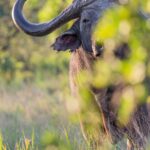The Secret Life of Giraffes
Getting to know the gentle giants of Madikwe Game Reserve
Towering above the bushveld, giraffes are some of Africa’s most iconic animals—instantly recognisable for their long necks, patterned coats, and elegant stride. But beyond their striking appearance lies a rich and complex inner world. These gentle giants lead fascinating lives filled with intricate social dynamics, surprising adaptations, and behaviours that often go unnoticed.
Much of what we now understand about giraffes is thanks to Canadian biologist Anne Innis Dagg, widely regarded as the world’s first “giraffologist.” In the 1950s, Dagg defied convention and travelled to South Africa to study giraffes in the wild—long before women were widely accepted in field science. Her pioneering research revealed that giraffes are far more socially and behaviourally complex than anyone had realised.
Here are some of the lesser-known aspects of giraffe life—many of which you might just witness on safari in Madikwe.
Complex Social Circles
Long assumed to be mostly solitary, giraffes actually form dynamic, loosely structured social groups. These fission–fusion herds often consist of adult females and their calves, creating shared nurseries where young giraffes can play while mothers keep watch. Males, meanwhile, may travel alone or form bachelor groups, engaging in ritualised “necking” matches to establish dominance.
Studies have shown giraffes tend to reconnect with familiar individuals, suggesting a level of social memory. These bonds are subtle and flexible but deeply meaningful—redefining how we understand their social world.
Light Sleepers
Giraffes are among the lightest sleepers in the animal kingdom. As prey animals, they rarely let their guard down—sleeping for just a few minutes at a time, and often while standing. Even when lying down, they keep their heads raised, always alert to danger. You’re more likely to see them browsing than snoozing.
Quiet Communicators
For a long time, giraffes were believed to be virtually silent. But studies—including Dagg’s observations—have shown that giraffes communicate using infrasound, low-frequency vocalisations below the range of human hearing. These subtle sounds help them coordinate within their herds across long distances.
Astounding Adaptability
Giraffes can thrive in a range of environments, from savannahs and acacia woodlands to arid desert regions. In Madikwe, they make the most of the reserve’s mixed terrain, browsing on leaves high in the canopy that other herbivores can’t reach—thanks to their nearly 50cm-long, prehensile tongues. Anne Innis Dagg’s early field studies revealed just how remarkably adaptable giraffes are when it comes to food sources and habitat. She observed that giraffes not only shift their diets based on seasonal changes but also show strong plant preferences, often favouring specific trees like acacias for their nutritional value and high water content.
Dagg’s research also challenged the long-held belief that giraffes needed constant access to open water. She noted that in drier regions, giraffes can survive for extended periods by extracting moisture solely from the foliage they eat—demonstrating a remarkable evolutionary adaptation to life in harsh, arid environments. This flexibility allows them to endure dry seasons and flourish in landscapes where many other large mammals would struggle.
Tongue Twister
Those signature black tongues aren’t just long—they’re tough and nimble. Giraffes use them like a fifth limb, deftly stripping leaves from thorny branches without injury. The dark pigmentation even helps protect them from sunburn, especially important as they feed for up to 12 hours a day under the African sun. Dagg was one of the first scientists to document how giraffes use their tongues with extraordinary precision, particularly when browsing acacia trees—whose branches are often laden with sharp thorns.
It was observed how giraffes wrap their muscular, prehensile tongues around leaves with incredible finesse, avoiding thorns while pulling vegetation into their mouths. She noted that their upper lips also play a key role in feeding, working in tandem with the tongue like a coordinated toolset. These adaptations allow giraffes to exploit a food source that many other animals avoid, giving them a crucial advantage in competitive browsing environments.
Unique Feet
Despite their delicate appearance, giraffes are incredibly well-equipped for life on the move. Their hooves can span up to 30cm in diameter and are soft underneath to absorb impact. These specialised feet help them traverse everything from rocky slopes to soft sand.
A giraffe’s kick is also a powerful defence. Even lions think twice—especially when a mother is protecting her calf. Their legs and feet are not just built for walking, but for survival.
Strong Hearts
Standing up to 5.5 metres tall, giraffes need an exceptionally strong cardiovascular system to keep blood flowing to the brain. Their hearts can weigh up to 11kg and beat with incredible power. Special valves and adaptations in their necks prevent fainting when they lower and raise their heads.
A Legacy of Curiosity
Much of what we now know about giraffes was pioneered by Anne Innis Dagg, a trailblazing Canadian biologist who, in the 1950s, travelled alone to South Africa to study these animals in the wild. Her early observations—ranging from social behaviours to feeding patterns—laid the foundation for giraffe science today.
Thanks to researchers like Dagg, we now appreciate giraffes as socially intelligent, adaptable creatures—far more complex than their once one-dimensional reputation suggested.
Come See for Yourself
There’s no substitute for witnessing giraffes in the wild. At Madikwe Game Reserve, guests at Tuningi Safari Lodge often enjoy extraordinary sightings of these animals—browsing gracefully through the bush, nuzzling their young, or silhouetted against the African sunset.
Join us for a closer look at the secret life of giraffes and the many wonders of the wild.





